NEWS
GU hands over Kristineberg
NEWS
Safe place for research data
REPORT
Protecting language diversity

Religion concerns everything according to professor Göran Larsson
INDEPENDENT STAFF MAGAZINE AT THE UNIVERSITY OF GOTHENBURG #1 MARCH 2024
GUJORNAL
12
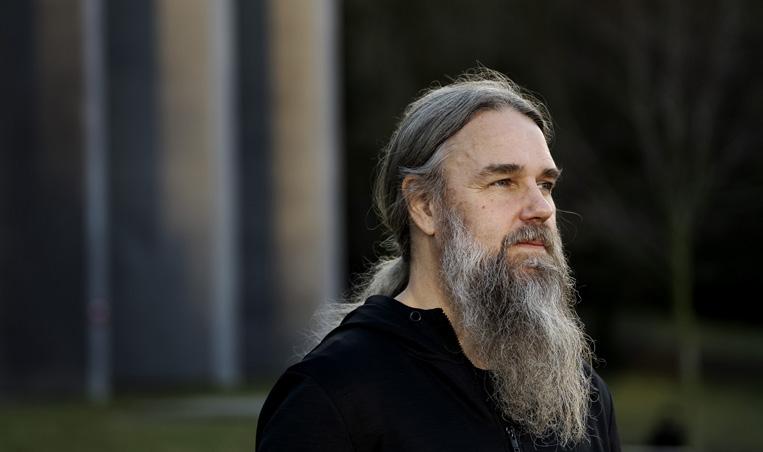
Contents
GU JOURNAL
The GU Journal has a free and independent position, is made according to journalistic principles.
Editor-in-chief: Allan Eriksson, temporarily on leave.
Editor:
Eva Lundgren
Phone: 031–786 10 81, e-mail: eva.lundgren@ gu.se
Photographer: Johan Wingborg, Phone: 070–595 38 01, e-mail:
johan.wingborg@gu.se
Layout: Anders Eurén, Phone: 031–786 43 81, e-mail:
anders.euren@gu.se
Address: GU Journal, University of Gothenburg, Box 100, 405 30 Gothenburg , Sweden.
E-mail:
gu-journalen@gu.se
Internet: gu-journalen.gu.se
ISSN: 1402-9626
News 04–11
04 GU hands over Kristineberg.
06 Safe environment for reseaech data.
08 This is NATO.
10 New house for public health.
Profile 12–15
22 Göran Larsson wants to understand extremism.
Report 16–19
26 Culture part of democratic education.
28 Bring cultural objects back to Bolivia.
People 20–22
20 Understanding other cultures through language.
22 Marina Panova is new manager at Tjärnö.


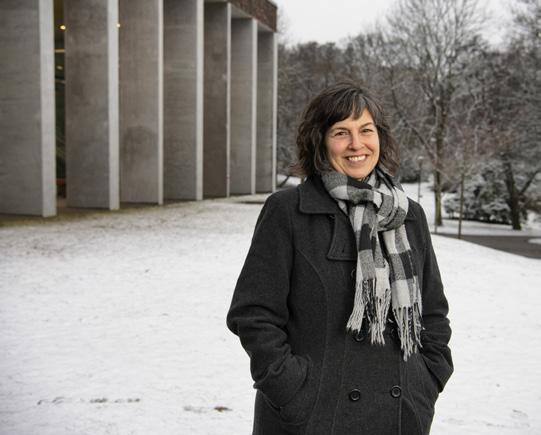
2 GUJOURNAL MARCH 2024
20 18
With a passion for languages.
Sending back cultural objects.
Profile Göran Larsson. 08
What does it mean to join Nato?
”Small and smart” –a narrow strategy?
t the end of January, Primula, the employee administration system used by many of our state institutions, had to be shut down due to a ransomware attack. Although most of you likely do not use the system daily, its functions remain vital, not only in order for your salaries to be paid correctly. As the security situation in the world grows more severe, these types of attacks will unfortunately become more prevalent. The University was already on the alert and continues to systematically work towards detecting and taking measures against cyberattacks. Owing to this vigilance, we discovered the problem at a very early stage and were able to shut down the connection to Primula in order to protect our remaining IT environment. A couple of weeks ago, Primula reopened, and we have since been able to return to work as usual. I would like to thank each and everyone involved in dealing with the situation who worked tirelessly to combat the threat while keeping the rest of us informed. I would also like to thank everyone else who remained patient while this issue was being dealt with.
The university board had a meeting the very day this journal was sent to print. Two significant reports were discussed in order to properly establish the facts and decide which actions should be taken as we move forward. The first of these concerns the IT faculty’s organisation and location. As most of you probably recall, the lead-up to this is Chalmers University’s decision to eventually leave Lindholmen, which in turn will have an effect on us. The second report concerns the organisation and management of the marine field sta-

tions, Tjärnö Marine Laboratory and Kristineberg Center for Marine Research and Innovation. It is based on the goal that the Faculty of Science should, in time, reach a balanced budget. You can read more about it in this journal.
Throughout the start of this year, I have had the opportunity to meet with my vice-chancellor colleagues on several occasions. The first time, we had a meeting with the research financers where we talked about our contributions to the research bill and our views on the development of Swedish research. My fellow vice-chancellors and I also met with State Secretary Maria Nilsson, who spoke to us about our sector’s challenges and priorities that the government is currently working on. These partly concern the research bill, partly the Ministry of Education’s development of a so-called STEM strategy. The specific aim of this strategy is to strengthen young people’s interest and knowledge in the natural sciences, technology, engineering, and mathematics. The expression has always been that Sweden is a “small and smart country”, with our success largely owing to our high level of engineering and innovation. The government opines that a small country needs to set its priorities and that this will be done by making investments based on the aforementioned STEM strategy. Many of us pointed out that Sweden also needs to promote the research and education of other fields in order to overcome present as well as future challenges.
The State Secretary also put emphasis on the uncertain situation in the world and the importance of universities improving their security work and conducting risk analyses whenever we initiate new international collaborations. Due to the security situation, a special investigation has also been carried out on behalf of the government. It covers the enhancement of competence concerning security matters within university boards. We vice-chancellors have also discussed this matter in detail together. All that remains is to wait and see which proposals the government elects to proceed with.
 MALIN BROBERG
MALIN BROBERG
Culture as Memory, Language and Source of Knowledge
hen the Museum of World Culture returned 24 Yaqui artefacts in June 2022, the American president took the time to attend the ceremony at the Mexican Embassy. This was not done at leisure. On the contrary; the same day NATO exercises were being held in Stockholm and there was a UN conference as well. The gesture signals an extent of reverence for cultural artefacts which is commonplace in many parts of the world, which we in Sweden perhaps sometimes overlook.
Creating art is part of what makes us human. As Associate Professor Carina Borgström Källén brings up, no human society has ever been completely devoid of culture. That art is a source of knowledge and therefore essential for children’s and young people’s education is something that will be further discussed in the symposium On culture and democracy, artistic education in changing times, as arranged by the Artistic Faculty.
Language is also part of culture. Guest Professor Leora Bar-el talks about how tied our mother tongue is to our identities. When a language dies, not only is a means of communication lost, but a whole world of ideas, traditions, stories, and life lessons are gone forever.
Religion is, of course, also part of culture. In this issue, we will acquaint ourselves with Göran Larsson, who thinks the Science of Religion is the best subject of all!
Eva Lundgren
GUJOURNAL MARCH 2024 3
Masthead
Vice-Chancellor
GU hands over Kristineberg
The University of Gothenburg hands over responsibility for Kristineberg Center for Marine Research and Innovation. Negotiations are being initiated with RISE about taking over ownership.
At the same time, the University of Gothenburg continues to operate the Tjärnö Marine Laboratory.
This was revealed in a letter from the Faculty of Science to the Vice-Chancellor on February 1.
IN JUNE LAST YEAR, the Vice-Chancellor tasked the Faculty of Science with investigating which marine research station should no longer operate under the auspices of the University of Gothenburg. On January 25 Ingrid Petersson presented her proposal, that the University give up ownership of the Kristineberg Center for Marine Research and Innovation, and remain as the sole owner of the Tjärnö Marine Laboratory.
– Both stations are excellent and carry out important operations, Dean Göran Hilmersson points out. But field stations are expensive and running two facilities is simply not financially sustainable, the faculty has no excess funds to draw on. The faculty therefore proposes that the university hands over ownership of Kristineberg but retains Tjärnö, which is
considered the larger one, with more extensive education and research facilities. It is better to invest where we already have more extensive operations.
The Kristineberg Center for Marine Research and Innovation was founded in January 2022 with the University of Gothenburg as its principal and in collaboration with the IVL Swedish Environmental Research Institute, Chalmers, the KTH Royal Institute of Technology and Research Institutes of Sweden (RISE). The research station is one the oldest in the world with prominent operations within several fields, e.g. deep sea research.
– RISE has shown interest in taking over ownership, which I think would be an excellent solution. But if that does not work out, we will invest all our energy into
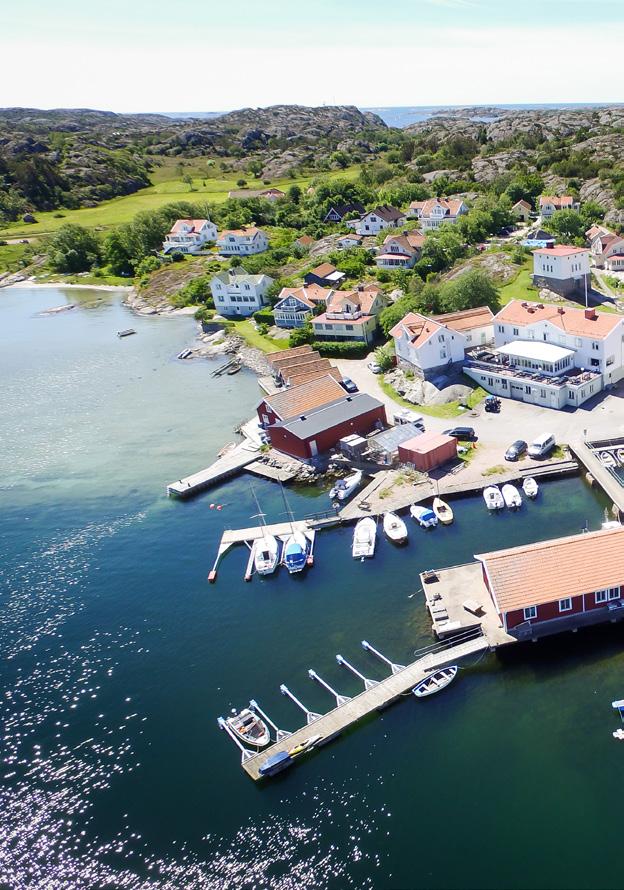
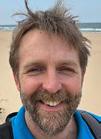
» ... our employees are more than willing to contribute as best as they can.«
Linus Hammar Perry
finding another solution, explains Göran Hilmersson.
Linus Hammar Perry is the manager at Kristineberg. He points out that the centre’s partnership has had little time to develop – a mere two years – and that the comparison with Tjärnö was perceived by many to be somewhat lacking in objectivity.
– We also regret that the
4 GUJOURNAL MARCH 2024 News
Kristineberg

stations were pitted against each other, which was not necessary to reach that same conclusion, that Kristineberg is more suitable for a new owner when the university feels that they cannot keep both.
– But Kristineberg has had another owner for 131 years, so this is nothing new. If another party is interested in investing in our operations
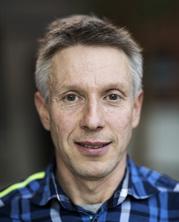
and looking to the future, our employees are more than willing to contribute as best they can. If RISE takes over, the operations will probably shift somewhat towards technological development, which is something that we are already striving towards in our mission statement. However, it is vital that the change does not undermine the excellent existing marine research that defines the station, and that the University of Gothenburg continues to be an active part of the centre.
The inquiry also proposes that negotiations with a new principal should be initiated promptly in order to have an agreement in place before the end of June 2024 and enabling a transfer by January 1, 2025.
– I respect the researcher’s opinion that negotiations should not be unduly delayed, says Linus Hammar Perry. But it is also important that the negotiation process respects the operations and does not come to too hasty a decision.
Marina Panova, manager of the Tjärnö Marine Laboratory, hopes to see both Tjärnö and Kristineberg continuing to develop.
– Increased investment in
Tjärnö, with new researchers and more projects, would of course be interesting. But currently, the focus must be on making good decisions for the staff at Kristineberg.
It is important for the university to remain at Kristineberg, Göran Hilmersson stresses.
– The University of Gothenburg wants to continue to develop their eminent marine operations, and Kristineberg will be playing an important role in that in the future as well.
Eva Lundgren
→ Facts: Kristinebergs zoologiska hafsstation (the Kristineberg Zoological Sea Station ) was founded in 1877 and was run by the Royal Swedish Academy of Sciences up until 2007, in close collaboration with the University of Gothenburg. From 2008–2017 the station was part of the Sven Lovén Centre for Marine Sciences, which in 2017 changed its name to the Sven Lovén Centre for Marine Infrastructure. Since 2018, the station has belonged to the Department of Marine Sciences. In 2022, the consortium, the Kristineberg Center for Marine Research and Innovation, was founded with the University of Gothenburg as its principal and in collaboration with the IVL Swedish Environmental Research Institute, Chalmers, the KTH Royal Institute of Technology and RISE (Research Institutes of Sweden). Several inquiries into the university’s field stations have been conducted over the years. The most recent, Organisation och styrning av de marina forskningsstationerna (Organisation and Governance of the Marine Research Stations), was presented on January 25 by Ingrid Petersson, former Director General of the Formas research council, and author of the Government remit En effektiv organisation för statlig forskningsfinansiering (Effective Organisation for StateFunded Research).
GUJOURNAL MARCH 2024 5
Drone
Photo: EDUARDO INFANTES
Göran Hilmersson
GU hopes that RISE will want to take over the Kristinebarg Center for Marine Research and Innovation.
Photo: JOHAN WINGBORG
Safe environment for research
In January 2024 a new IT environment was introduced at the University of Gothenburg that will facilitate the correct management of protective research data. Storage, scientific processing and sharing of the data will be done on central servers.
– The researchers will process and analyse their data through a remote desktop in a Windows environment. The solution will make it easier to comply with all the legal requirements pertaining to security, documentation and archiving, says Max Petzold, Deputy Vice-Chancellor and the chair of the committee for the Safe IT Environment project.
THE TRE PROJECT (Trusted Research Environment) was initiated in September 2022. It included forming a committee comprising researchers tasked with ensuring that the services being developed corresponded to the needs of the target audience. The environment was tested and developed throughout the autumn based on the feedback that was provided.
Since January of this year, the environment is available to university staff.

– The environment is secure, but we cannot admit everyone who is interested immediately. We will test the capacity and the user interface using a limited number of projects with sensitive personal data at the beginning of 2024, Max Petzold tells us. Hopefully, we will be able to give access to everyone who is interested in the spring. We will also expand functionality from only statistical analysis to software for qualitative analysis as well as audio and video.
The TRE project is primarily about creating high-level security for the processing and
» Ideally, all research will take place in the secure environment, from data collection, processing and analysis, to documentation and archiving. «
Max Petzold
storing of university research data. But the system is also intended to help researchers do things correctly.
– FOR EXAMPLE, instead of having all the information on your own computer or server, where you are personally responsible for complying with all the relevant statutory requirements, security, software updates, documentation and archiving, all of that can be managed in a shared environment, says Mathilda Perisa, who was appointed Information Security Manager at the university last year.
For researchers, the TRE
6 GUJOURNAL MARCH 2024
News

system may in part entail a whole new way of working, explains Max Petzold.
– AS TRE IS INTENDED for work with sensitive personal data, researchers will first have to classify their data. This is a requirement for all research data management, but will be an initial step for working with TRE. Ideally, all research will take place in the secure environment, from data collection, processing and analysis, to documentation and archiving. Of course, in many instances this will not be possible, patient data, for example, must be obtained externally.
Researchers will also be able to invite colleagues from other universities or industry to work in the TRE environment.
– Sending information between different groups always involves some risk, which is eliminated if everyone is working in TRE, Max Petzold explains.
Martin Adiels, Senior Lecturer in Health Science Statistics, is one of the researchers who tried out the new
research data environment.
– I have worked before in other environments with similar aims, but they required quite high-level technical know-how. They were complicated for users who wanted to concentrate on the job at hand. The TRE environment is much easier to work with, and also offers support if problems should arise.
Martin Adiels has moved several projects into TRE without having to change his way of working.
– But for others it could of course be quite an adjustment. I think the system works well. The only problem is that it is difficult to retrieve tables and other information from the internet, but that will probably be solved in the future.
THE UNIVERSITY OF Gothenburg ranks quite high among Swedish universities and colleges in terms of secure research data environments, says Max Petzold.
– Many people are impressed with how we managed to get the system up and running in such a short time.
To further support the work on data security, a new Information Security Council has just been set up.
– MY WORK ALSO includes drafting a new information security policy, says Mathilda Perisa. The latest version is from 2014, and is a reworking
→ Facts: Trusted Research Environment-projektet (TRE), commenced in September 2022 with the aim of enabling the university to:
comply with the statutory requirements and recommendations concerning storage, processing and traceability of data with information class 3
create conditions for research projects to safely share data with external parties
store sensitive information in correct locations, encrypted, secure and under strict control
create a homogeneous, secure IT environment
create an automated process for setting up and closing down individual secure environments.
of the policy from 2007, so it is really about time. The information security policy will govern the development of our management system for information security.
Text: Eva Lundgren
Photo: Johan Wingborg
The concept was tested in the autumn of 2023 and since January 2024, there is a first version available to university employees.
Mathilda Perisa was appointed Information Security Manager at the University of Gothenburg in August 2023. She is in charge of managing, coordinating and administering the university’s new management system for information security.
A new information security council was set up in January, consisting of Max Petzold, IT Manager Tony Ottosson Gadd, Chief Legal Counsel Sara Dahlberg as well as the future Security Manager.
If you are interested in participating, please contact TRE@gu.se.
GUJOURNAL MARCH 2024 7
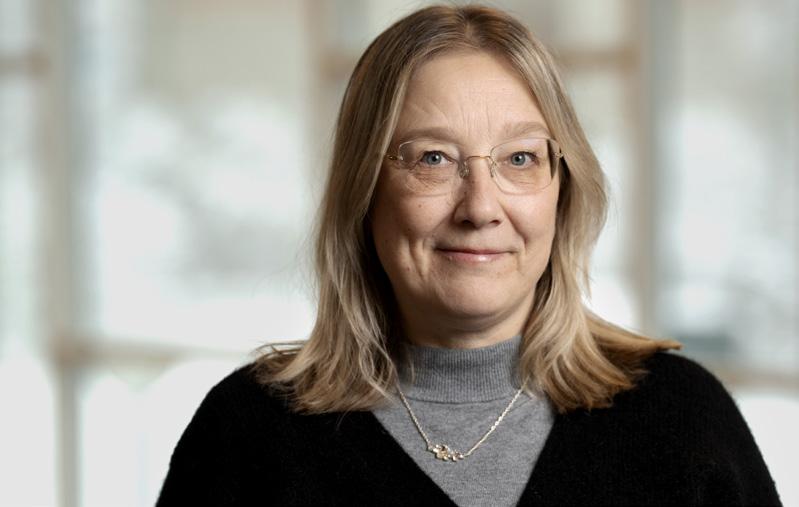
This is what joining Nato means
Following Turkey’s approval of Sweden’s NATO appli cation, only a green light from Hungary remains. But what does it really mean, being part of NATO? The GU Journal asked Ann-Marie Ekengren, Professor of Political Science and an expert on Swedish foreign policy.
WHEN SWEDEN SUBMITTED their NATO application on May 28, 2022, many people, including NATO’s Secretary General Jens Stoltenberg, thought the process would take no time at all. It has not really played out like that though. It was not until January 25 this year that Tur kish president Recep Tayyip Erdogan signed off on the application.
– The pressure on Hunga ry to also approve Sweden’s application is now considerable, but I cannot venture a guess as to when that might happen, Ann-Marie Ekengren explains.
Of course, the reason why

»As a member of NATO, we are included in the alliance's reciprocal defence.«
Ann-Marie Ekengren
while left-wing governments have highlighted the UN and international involvement. But regardless of government, Sweden has still been seen as a global stakeholder in terms of certain values. Now we prioritise security policy, which may mean that Sweden’s ability to be actively involved in other multilateral contexts will diminish.
Another reason for the
8 GUJOURNAL MARCH 2024
News
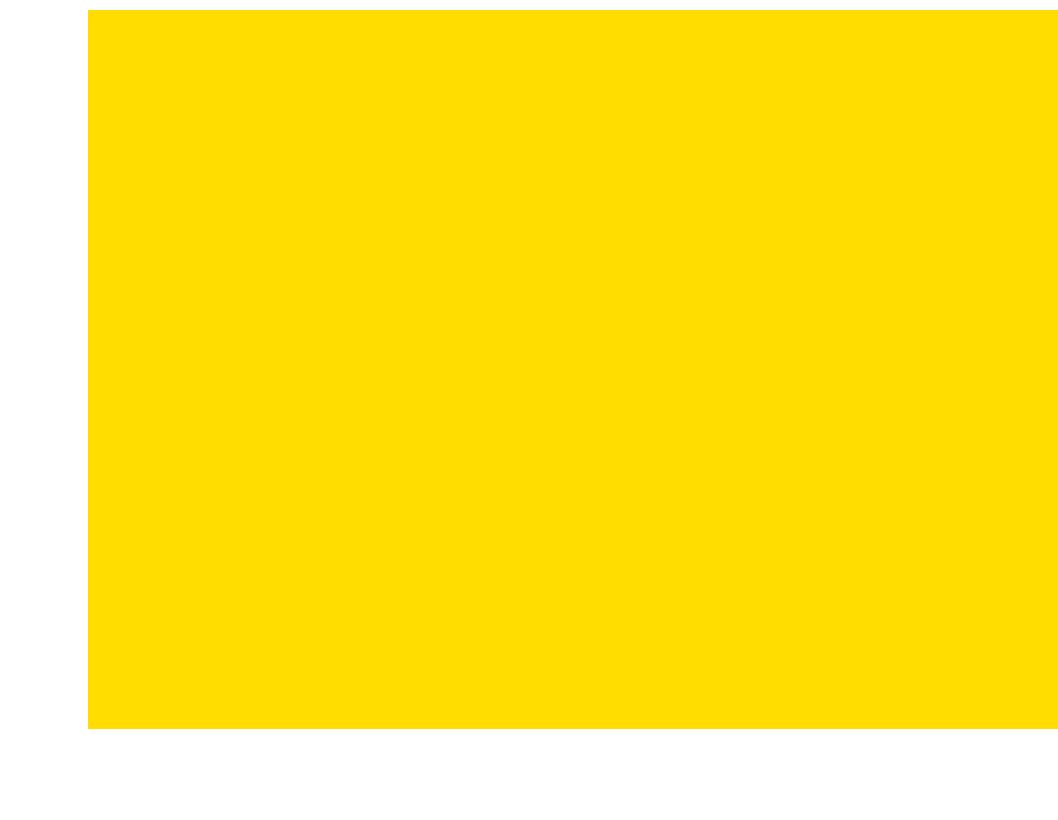
Illustration ANDERS EURÉN
New Health Science Centre filled with events
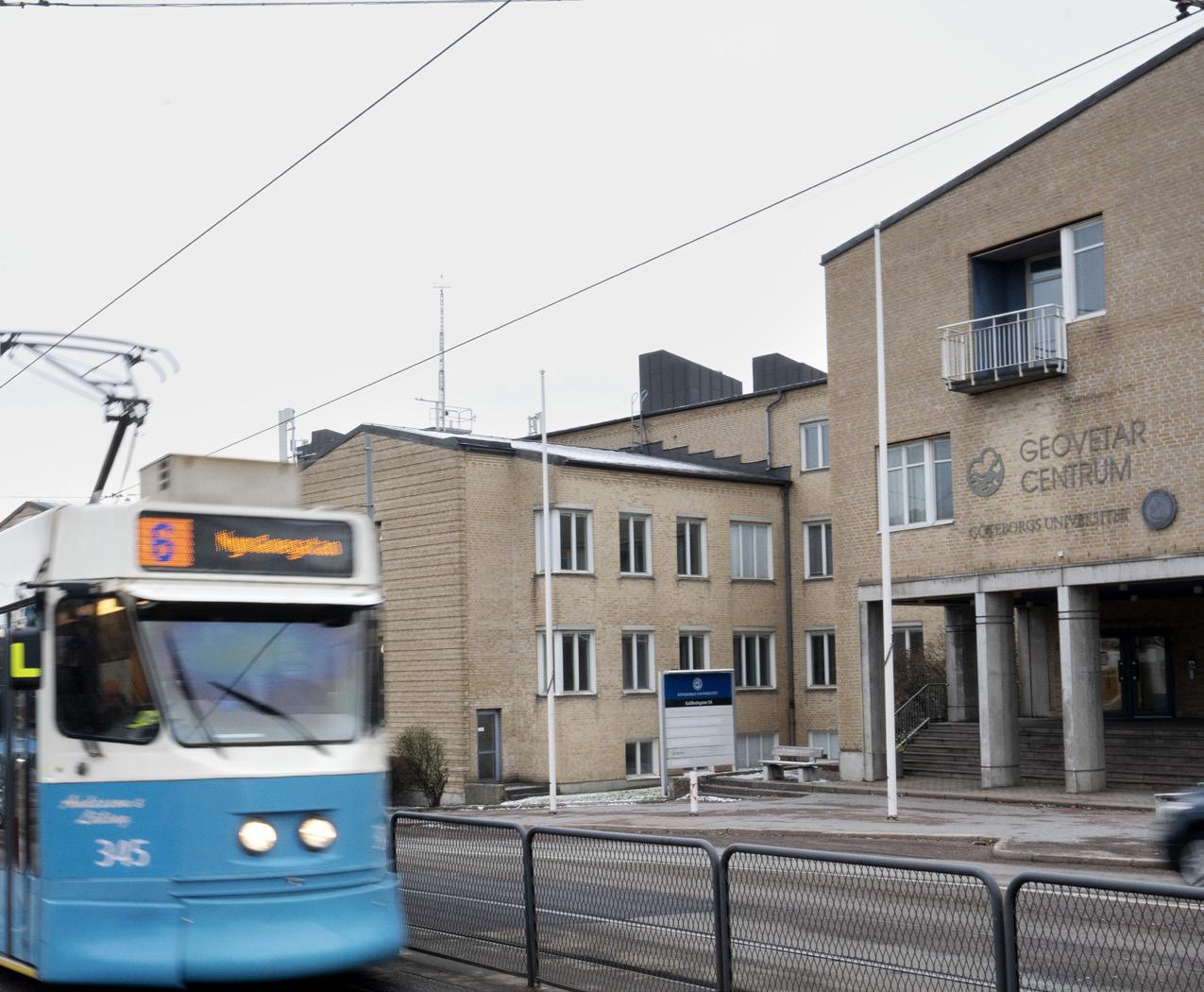
Come autumn, the School of Public Health and Community Medicine will move into newly renovated premises at the Earth Science Centre, which will change its name to the Health Science Centre (HVC). They will be joined by the Gothenburg part of the Regional Health’s Research, Development, Education, and Innovation organization.
– Being located together will facilitate collaboration, workshops and other activities. It will simply be more fun going to work, says Department Manager Maria Åberg.
THE SCHOOL OF PUBLIC HEALTH and Community Medicine is currently divided across three different buildings at Medicinareberget, says Maria Åberg, Professor in General Practice.
– According to our vision we will collaborate, in both research and education, and thus contribute to better health, locally and globally. But in order to engender collaboration you have to meet, and that is difficult when employees are based at different premises. But this autumn the entire school, around 135 people, will be based in the Health Science Centre. Around fifty employees at
the Regional Health’s Research, Development, Education, and Innovation organization, two employees from Angered Hospital as well as the staff of the Swedish National Data Service, comprising around 30 people, will also move in, so we are strengthening ties with our partners.
BESIDES THE STUDENTS at the university, there will also be training facilities for interns, consultants and medical officers.
– So we are getting a greater variety of students, which is also valuable. The Health Science Centre will truly come to life, explains
10 GUJOURNAL MARCH 2024
News

Ronny Gunnarsson, Professor of General Practice, who is in charge of the move.
IT WAS THE PREVIOUS Department Manager Max Petzold and then Vice-Dean Eric Hanse who came up with the idea two years ago to base the School of Public Health and Community Medicine at the Earth Science Centre. Because the earth scientists and cultural scholars that were housed there were to move to the new Natural Science building, Natrium.
– Originally, the plan was to move to the Zoologen on Medicinaregatan 18, Maria Åberg explains. But then we
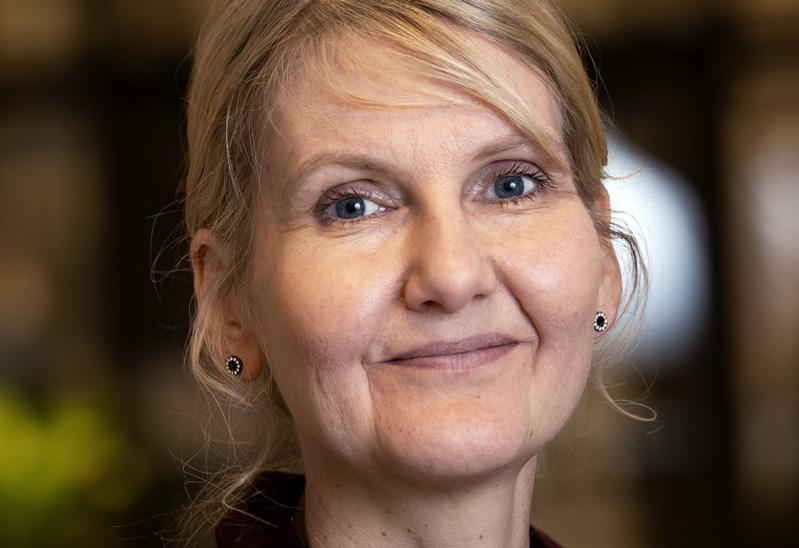
were told that the building was undergoing renovation and would not be available for two years. Of course, we did not want to move several times so when we heard the suggestion about the Earth Science Centre it did not take very long to convince the management team.
ONE IMPORTANT advantage of the new Health Science Centre is its beautiful atrium.
– We will be arranging for even more seating for students than is currently available. It aligns well with our new focus, which involves the creation of a better campus, Ronny Gunnarsson explains.
Other projects that the new premises will facilitate include an annual joint Day of Education and Research as well as our community outreach.
– IT IS THE 20TH anniversary for our Master’s programmes and we will celebrate that, but we also want to develop a new Master’s programme in biostatistics. And as we want to retain our broad base we also want to invest in cutting
»We are planning to arrange workshops and other events, we want there to be a lot happening in the building.«
Maria Åberg
edge research, such as in health economics.
The Earth Science Centre is familiar to many university researchers, not only to earth scientists and cultural scholars, says Maria Åberg.
– A number of years ago, the Gothenburg Ethical Review Board was located there, so many a researcher has rushed there to present their applications. We are planning to arrange workshops and other events, we want there to be a lot happening in the building. We are hoping that employees and students will choose to come to the Health Science Centre instead of working from home!
Text: Eva Lundgren
Photo: Johan Wingborg
→ Facts: The School of Public Health and Community Medicine is currently located at three addresses: Medicinaregatan 16 A, Medicinaregatan 18 A and Hälsovetarbacken, building 7. Come autumn, the entire school will relocate to the old Earth Science Centre at Wavrinskys plats and change its name to the Health Science Centre (HVC). Also, the Swedish National Data Service (SND), the Angered Hospital Research, Development and Education Department as well as the Gothenburg part of the Regional Health’s Research, Development, Education, and Innovation organization will move here.
The plan is to have the teaching premises ready to accept students on August 15, and the other organisations will move in later in the autumn.
The rent is estimated to remain at the current level.
GUJOURNAL MARCH 2024 11
Maria Åberg hopes the staff will fins the new enviroment exciting.
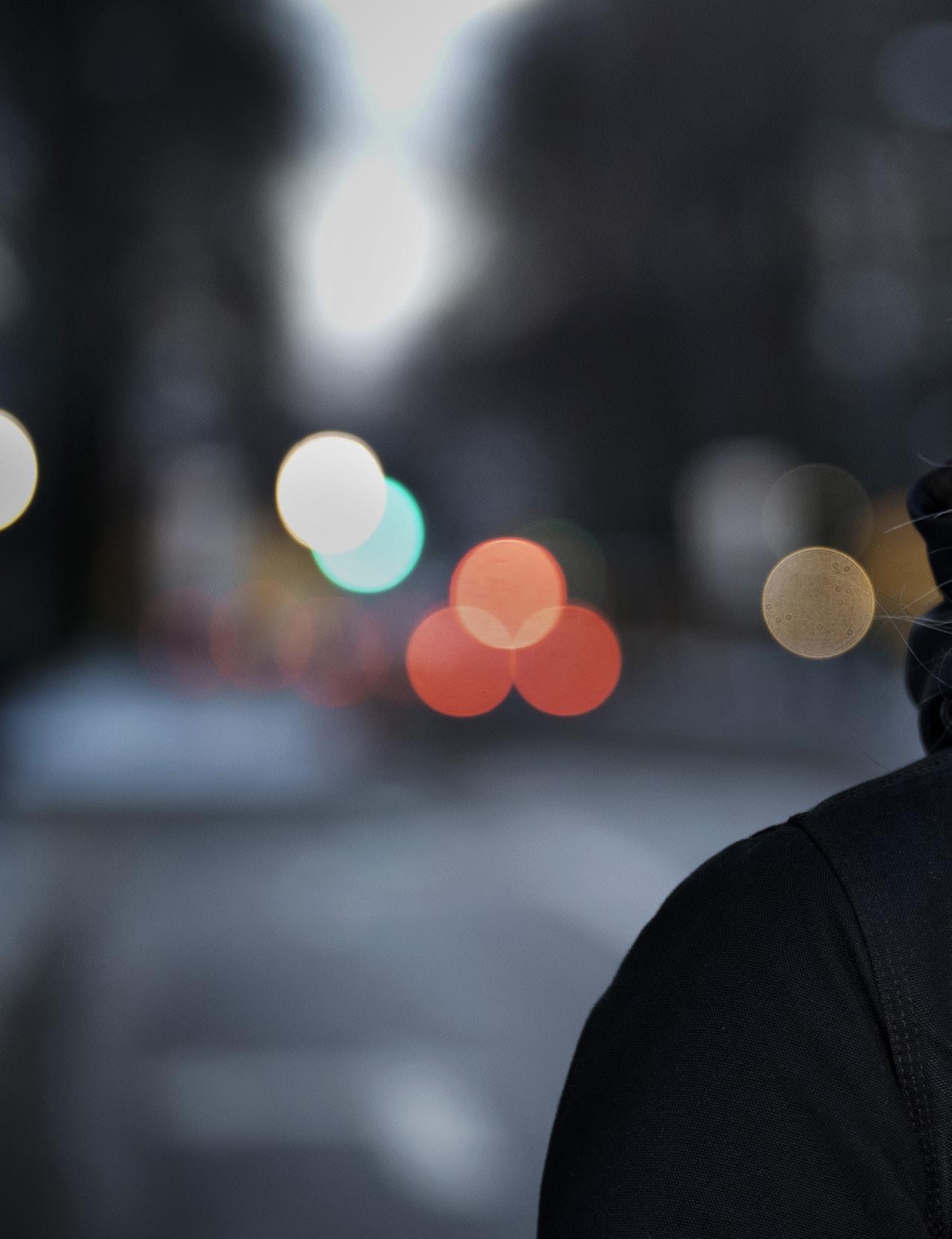
Studying the best subject of them all
Profile
12 GUJOURNAL MARCH 2024
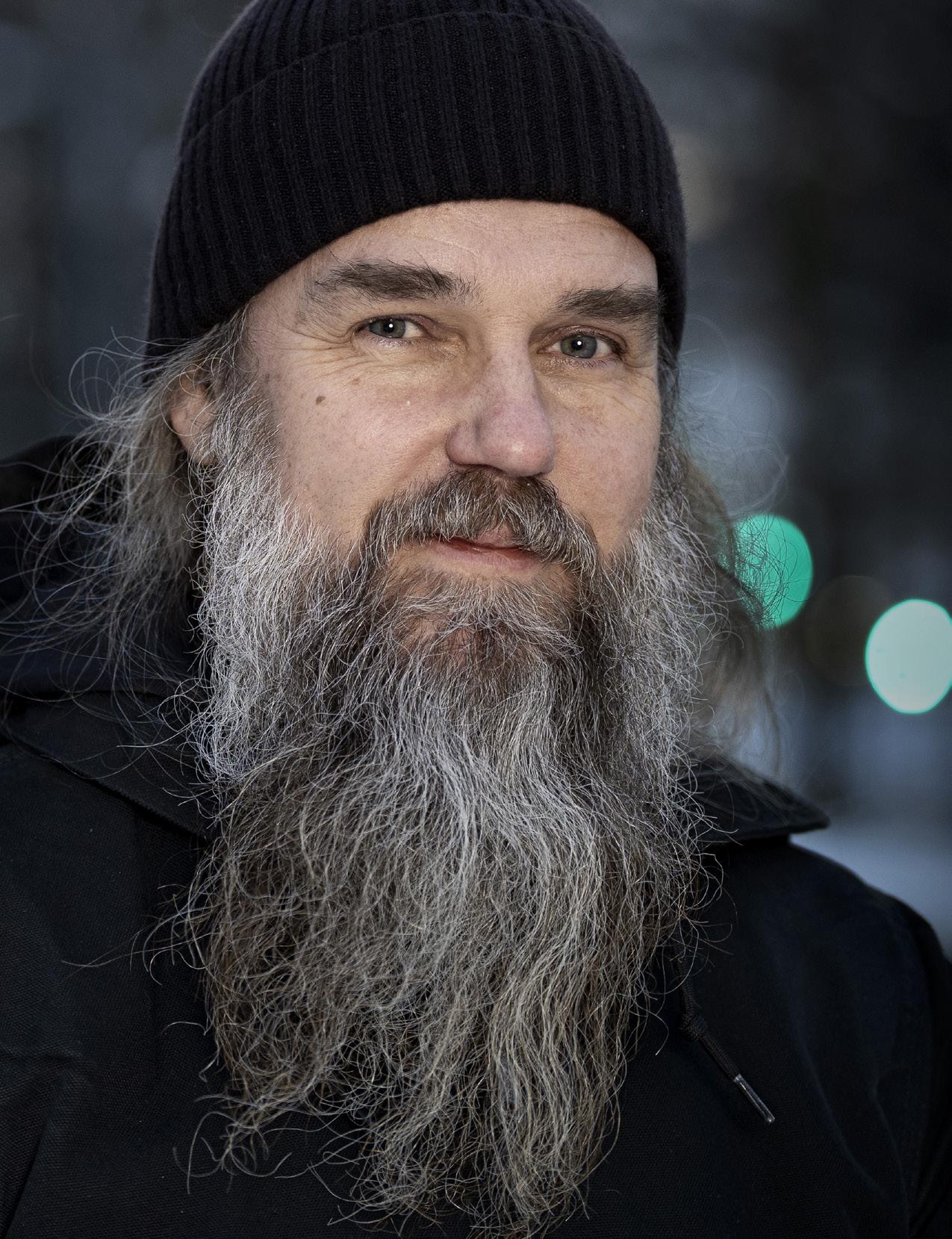
– Religion, what is that? The more I study the phenomenon, the more difficult it is for me to find an answer, explains Göran Larsson. He started out as a religious scholar but in recent years, he has become increasingly interested in the theory of science, methodology and how global conflicts impact Swedish society.
GUJOURNAL MARCH 2024 13
→
Text: Eva Lundgren | Photo: Johan Wingborg
ecently, Göran Larsson released a book about Geo Widengren who was Professor of History of Religion and Psychology of Religion from 1940–1973 at Uppsala University.
– It was when I became Pro Dean at the Faculty of Humanities in January 2017 that I decided to also do something enjoyable without a set deadline. I decided on Geo Widengren who was a strong influence on religious studies in Sweden, and who also once was my supervisor’s supervisor. It is important to have a historical perspective on your own subject; not everything was better in the old days, but neither was it worse, and what may be perceived as new today was perhaps tried back in the day. Among other things, Widengren thought that the Swedish school system in the 50s and 60s was in freefall, that university lecturers never had time to do research and that Sweden was a country of engineers, with no understanding of anything but mechanics. You occasionally hear those same assertions today...
Since 2012, Göran Larsson has been a professor of religious studies. He began his research on medieval Islam on the Iberian peninsula in 1995, and five years later he defended his doctoral thesis.
– At the time, Islam was just one religion among others. Certainly, the Islamic revolution in Iran in 1979 and the death threat against Salman Rushdie at the end of the 1980s shook many people, but there was no great concern about Islamic extremism. But then came September 11, 2001, and the U.S. War on terror. Unlike other wars, which involve taking territory, the war on terror has no end and can continue for eternity, something that still affects us today.
Since those days, Islamism and Islamic terror organisations have received much attention. At the same time, academia has been accused of not having the courage to address this type of problem.
– The criticism must of course be taken seriously, academia cannot ignore difficult issues. Instead, researchers need to be somewhat non-committal and in their search for answers avoid embellishing or denigrating matters. For example, studies show that most people in our country with an Islamic cultural background relate to their cultural heritage as Muslims much in the same way us non-Muslims do, even if, of course, extreme interpretations of Islam also exist.
Lately, Göran Larsson has become more involved in finding out how global conflicts find their way into Swedish society. Since 2015, he has been associated
with the Segerstedt Institute and for the past three years he is a visiting professor at the Academy for Police Operations at the University of Borås. The two jobs are linked.
– Around 20 percent of the current Swedish population have a foreign background. So many Swedes are culturally and emotionally linked to another place in the world. When news is disseminated on social media about Quran burnings, provisions in the Care of Young Persons Act, war and acts of terrorism, it can quickly have an impact on the thoughts and actions of people both in and outside of Sweden.
Göran Larsson is now part of a new project at the Segerstedt Institute about antisemitism and how conflicts in the Middle East impact Swedish schools.
– Today, many issues seem to be so difficult that teachers opt not to bring them up in their teaching. But if the conflicts are not addressed in school, the problems will become much worse further down the road.
At the Police Academy, he teaches about the religious landscape in Sweden, about integration and segregation, and about differences between urban and rural communities in terms of trust and lines of contention.
– With good information, the police will hopefully be able to work more effectively to prevent crime and protect people. But the students can sometimes point out that of course getting information is a good thing, but what can they do about the problems? And that is the rub, of course. Teaching at the Police Academy is a healthy reminder about the daily realities of other professions.
Göran Larsson’s expanding interests have also encouraged him to write a popular science book about the now almost forgotten war between Iran and Iraq from 1980–1988.
– Chemical warfare as well as child soldiers were used, and for eight years there was trench warfare in a way that was reminiscent of World War I. Around one million people died, but the war did not lead to any border revisions or major political changes. But it did give both Ayatollah Khomeini and Saddam Hussein an opportunity to consolidate power and eliminate domestic opposition. The chaos and financial crisis that followed in Iraq led to the war in Kuwait from 1990–1991 and later to several of the current lines of conflict in the Middle East.
Even if the war between Iran and Iraq was not primarily about religion, there was a religious dimension, Göran Larsson points out.
– And this is often the case. For this reason, religious studies is the best subject in the world, as it encompasses everything: sociology, psychology, political science, history, art, ethics, law and medicine. Our universities are divided into different faculties, but religion spans several disciplines and subjects.
14 GUJOURNAL MARCH 2024 Profile
At the same time religious studies is a somewhat vague subject. Because, what is religion really?
– For most believers, religion is not about what a particular book says, but about community. The belief in certain dogmas creates a sense of belonging, and the fact that the various parts of a faith do not add up is not necessarily a flaw, but can instead be something positive and an opportunity: people can have very different views and still be part of the same belief system. Religion is also important for the various phases we go through as people, where milestones are often marked by rituals. But the way in which we think about religion is also about locations: in a church you may be imbued with spirituality but at an ice-hockey match something else is important.
Göran Larsson himself is indifferent to religion, which means that he does not see religion as something good or evil.
– Religion may urge people to commit crimes, as well as acts of violence and destruction. In his day, Saint Augustine spoke of “bellum iustum”, the just war. And you may wonder why people set out on the crusades in the Middle Ages, just as you might wonder about today’s followers of White Power movements or ISIS. But you will not necessarily turn into a crusader, White Power adherent or ISIS fighter after careful study of the Bible, Mein Kampf or the Quran. Instead, what you believe is closely linked to individual experience and societal dimensions. The inroads into and ways out of a violent ideology are part of the problems that I try to understand through my research.
Of course, religion can also inspire good deeds and provide meaning to life.
– One religion is not good while another is evil, one way of looking at a matter of faith is not worse than another. In Sweden, for example, we do not consider our choice of clothes or food to have anything to do with religion, but in many countries people have a very different opinion.
The principle of freedom of religion is therefore important, Göran Larsson argues.
– Large parts of the Middle East, Africa and Asia currently consist of authoritarian states with no freedom of religion or expression. It is not particularly strange that these people may have trouble understanding that burning the Quran is something that is done by individuals, and not something that the Swedish government gets involved in. But we have not always had freedom of religion in Sweden either, it was introduced as recently as 1951/1952. Before that, citizens were more or less forced to be members of the Church of Sweden or a religious community approved by the state.
The closest that Göran Larsson might get to a religious experience is when he listens to music.
– As a young man I was inspired by my older brother, who mostly was into heavy metal. But today I
am a musical omnivore. To me, music is closely linked to mood, and may provide energy before a difficult meeting, say. I also think it is important to find new musical impressions and would rather go to a new band’s first gig than to a mega-concert with the Rolling Stones. The philosopher William James pointed out that religion can entail an out-of-body experience and the same thing can apply to music: together with a large number of enthusiastic fans at a concert you can suddenly feel transported to a completely different place.
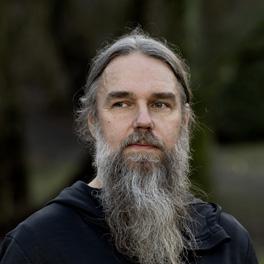
GÖRAN LARSSON
Works as: Professor of Religious Studies with a focus on History of Religion. Linked to the Segerstedt Institute and a visiting professor at the Academy for Police Operations, University of Borås.
His new book Geo Widengren. Stridbar professor i en föränderlig tid is published by The Royal Swedish Academy of Letters, History and Antiquities in collaboration with Langenskiöld Publishing House.
Family: Partner and four children. Lives in: Gothenburg.
What was the last book you read? Ett ord för blod by Faysa Idle.
What was the last film you watched? Düsseldorf, Skåne.
What are your hobbies? Music, baking, preferably Swiss roll, and being with my family.
GUJOURNAL MARCH 2024 15
Symposium on children’s right to culture
Culture, cultural heritage and democracy are the themes for a symposium focusing on children and adolescents that will be held on April 24. It is the research platforms PLACE and ERA at the Artistic Faculty, as well as the BiG network, that are organizing it together with the Museum of World Culture.
– Art is education. And the opportunity to experience art is the opportunity to educate yourself, argues Staffan Mossenmark, Tarja Karlsson Häikiö, Onkar Kular and Carina Borgström Källén who are organising the symposium.
– We aim to reach students, doctoral students, university colleagues, partners and others who are interested in issues relating to children, young people, democracy and public spaces, says Onkar Kular, Professor of Design. We are hoping to attract practitioners from the school sector but also from other areas. Our primary goal is to support the right of children and adolescents to express themselves, thus contributing to a democratic world.
Grown-ups have a tendency to unnecessarily infantilize art that is intended for children, adapting it and making it easily accessible, says Staffan Mossenmark, Professor of Composition.
– But why should adults decide what children can handle? Why can we not, for example, play music that has a depth and a complexity? The bar may well be too high, and the children do not have to reach it or exceed it.
Art is a window to reflection, where nothing is right or wrong, and where you have an opportunity to use your imagination to understand someone else, argues
Tarja Karlsson Häikiö, Professor of Visual and Material Culture.
– I myself have an immigrant background and I both learned Swedish and gained new insights by reading books by
Isaac Asimov at a very young age. Where would I be today without the library in Torslanda?
Art has always existed in all societies, and yet it is not obvious to make art available so that all children can participate on equal terms, explains Carina Borgström Källén, Associate Professor of Music Education.
– Currently, aesthetic subjects in schools are being questioned, and culture schools and after-school centres are getting less funding, because politicians do not understand that art and knowledge are intimately linked.
Artistic practices also constitute a toolbox that enables freedom of expression for people, enabling them to express criticism and alert others to injustices, argues Tarja Karlsson Häikiö.
– The space that an artist inhabits to make their voice heard should be available to others as well.
Anyone who has not been taught what art is, believes it to be some additional spice in life, and do not realise that art is a prerequisite for our democracy, says Staffan Mossenmark.
– Even my skilled music students have difficulty understanding that they need to place themselves in a wider social context and not just devote themselves to their own instrument or creation.
Art is something that you must experience yourself, you cannot let someone else do that for you, argues Onkar Kular, Professor of Design.
– Children have a right to their own expression and must be given an opportunity to make their voices heard.
In order to strengthen research internally, but to also reach out to external stakeholders, the Artistic Faculty has invested in several research platforms. Two of these are behind the symposium. One of them is ERA
– Our role is to gather and develop pedagogical research into the aesthetic school subjects. We support teacher training in the aesthetic subjects and assist colleagues with their research applications, Carina Borgström Källén tells us.
– Our perspective is not only one of educational science, we see our subjects as a bridge to other fields. One important aspect is to disseminate our research, which we for example do through our podcast, says Tarja Karlsson Häikiö.
The second platform is PLACE.
– We gather and develop existing research within the government’s policy for Designed Living Environment, Staffan Mossenmark explains. It is about increased democratisation and influence over living environments, public spaces and meeting places, but also about increasing access to higher art education and commissioning art for public spaces. As researchers, particularly within the field of the arts, we operate in a bubble, we need better outreach and to bring on board the perspective of others.
The BiG research network, the aim of which is to highlight the research into children and adolescents that is being conducted in Gothenburg, is also participating. The BiG members come from a variety of backgrounds and span an extensive field.
The symposium on March 24 will include lectures, workshops, a film school and panel talks.
Text: Eva Lundgren Photo: Johan Wingborg
Facts: The Symposium On culture and democracy, artistic education in changing times is a collaboration between the research platforms Educational Research in the Arts (ERA), Public Life, Arts and Critical Engagement (PLACE), the network BIG –Barnkulturforskning i Göteborg (Research into Children’s Culture in Gothenburg) at the Faculty of Humanities and the Museum of World Culture. The originators and organisers are Staffan Mossenmark, Professor of Composition, Tarja Karlsson Häikiö, Professor of Visual and Material Culture, Carina Borgström Källén, Associate Professor of Music Education, Onkar Kular, Professor of Design and Karolina Westling, Senior Lecturer in Film Studies.
Date and venue: April 24 at the Museum of World Culture.
16 GUJOURNAL MARCH 2024
Report
»The bar may well be too high, and the children do not have to reach it or exceed it..«
STAFFAN MOSSENMARK

GUJOURNAL MARCH 2024 17
Onkar Kular, Carina Borgström Källén, Staffan Mossenmark och Tarja Karlsson Häikiö have taken the initaitive to a symposium on young people's right to culture.
Sending stolen artifacts home
This summer, 80 cultural artefacts that have been housed at the Museum of World Culture for 50 years, will be sent to Bolivia. These artefacts are the so-called Niño Korin collection which will be returned to the Kallawaya indigenous people.
One of the people who has been working on packaging the items is Adriana Muñoz, curator at the Museum of World Culture and researcher at the University of Gothenburg.
t does not look like much, the small bag with a pattern consisting of multi-coloured squares, which Adriana Muñoz is holding up.
– The bag is called wiphala and in spite of its humbleness, it has great symbolic value to the Kallawaya but also to other indigenous peoples in Latin America. For example, flags with wiphala patterns were used by activists at the climate summit in Rio de Janeiro in 1992 and the flag has also been used as a symbol of anticapitalism. But the pattern is much older than that, the small bag in our collection is from the 9th century.
In connection with Evo Morales being elected president of Bolivia in 2006 the matter of repatriation came up, Adriana Muñoz tells us.
– Morales was the first president in the country’s history with indigenous origins, which is remarkable considering that they comprise 70 percent of the Bolivian population. To Morales, the return of cultural artefacts was part of decolonizing his country.
The Museum of World Culture has 16,000 objects from Bolivia so it was no small task to decide which ones would be
appropriate for repatriation.
– We invited a group of Kallawaya in order to find out more about our collection. I worked for six months organising and making lists of the various objects.
Among the items to be returned are objects that belonged to medicine men, such as long tubes for powders, medicines, textiles, but also a skull. The man who acquired the items in the 70s – Henry Wassén, an employee at the Museum of Ethnography in Gothenburg – was highly interested in toxins and hallucinogenic drugs.
– With the help of the Swedish Embassy in Peru he, in breach of Bolivian law, was able to bring cultural artefacts to Sweden. Unfortunately, embassies are still being used to circumvent a country’s laws, Adriana Muñoz says.
The state museums of world culture is headed by a director general, appointed by the government. It is the government that, following an inquiry conducted by the authority, decides whether to repatriate an item.
– In this particular case, it was a simple decision. Because the museum’s archives had an enormous amount of public documentation about the acquisition, which is odd considering that the handling of it was illegal. The acquisition was also brought to Sweden a few years after UNESCO adopted a convention on the ownership of cultural artefacts in 1970; for older acquisitions one argument against returning objects can otherwise be that there were no international rules in place at the time.
But sometimes, returning items may be more difficult.
One such example is the handover on June 3, 2022, of 24 ceremonial items to the Yaqui indigenous people in northwestern Mexico, Adriana Muñoz explains.
– The collection is from 1934–1935 and
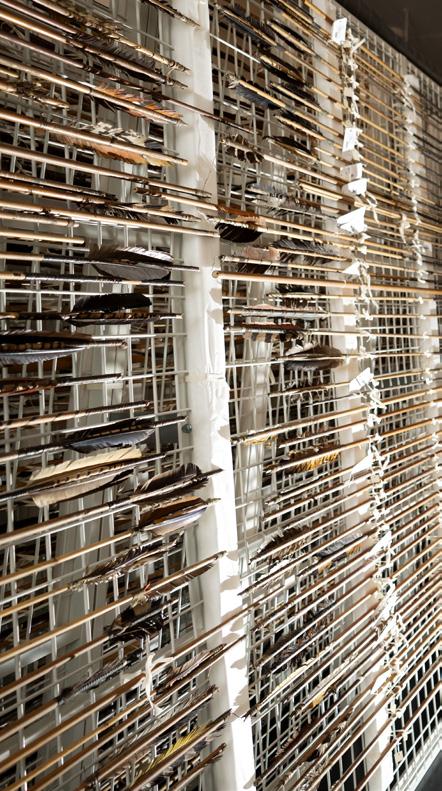
was acquired by ethnographer Gösta Montell and archaeologist Sigvald Linné together with the Danish sisters, Bodil Christensen and Helga Larsen. On this occasion it was not a matter of plunder, instead the items had been acquired with the permission of the Yaquis. Among the objects were two Maaso Koba, ceremonial stag heads used in dance ceremonies and perceived by the Yaquis as sacred living beings.
What complicated the return was that the Yaquis had become divided and it was not clear which group had the right to the objects. This is because at the beginning of the 20th century, during the so-called Yaqui Wars, many of the Yaquis were deported to Yucatán, others to Tlaxcala, while a third group managed to flee to Arizona. The group in Arizona eventually gained recognition as an indigenous people, which gave them the right to operate casinos, something which has led to some financial power.
Now, the Yaquis in Arizona felt that they had the right to the items. An inquiry was set up which eventually determined that the objects should be considered as testimonials of the Yaqui deportation and severe suffering and be returned to Mexico.
18 GUJOURNAL MARCH 2024 Report
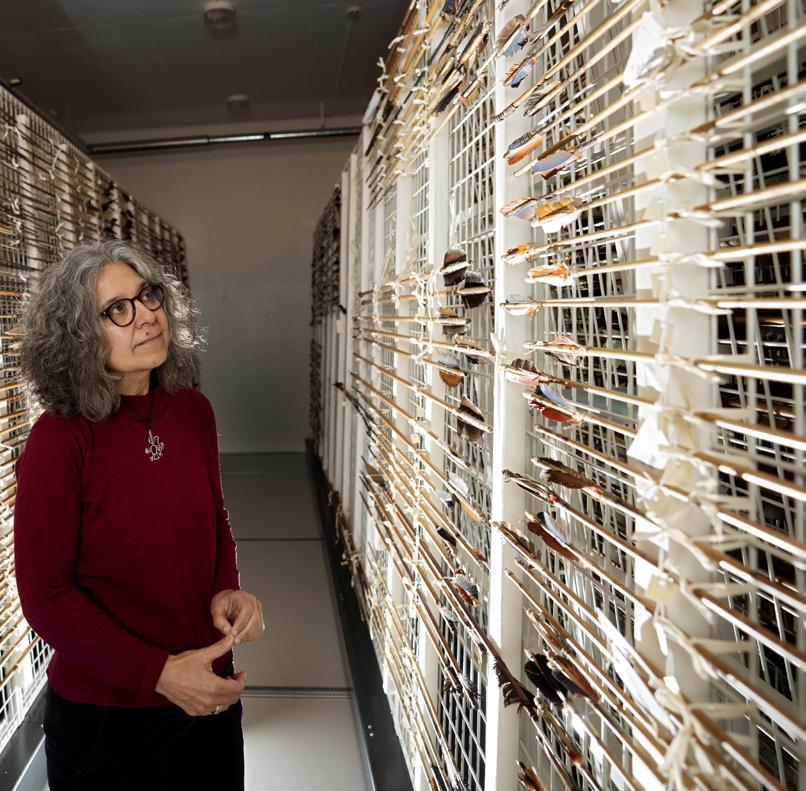
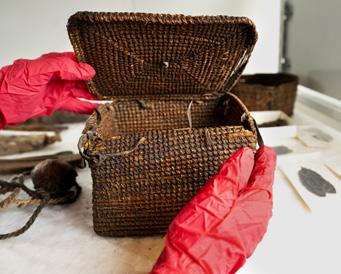
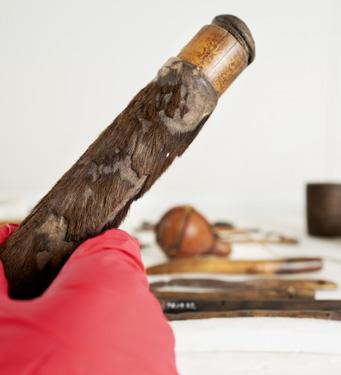

Repatriation of cultural artefacts is not only about justice. It is also about high-level politics, says Adriana Muñoz.
– The hand-over of the 24 Yaqui objects took place on June 3, 2022, at the Mexican Embassy. That day, large parts of Stockholm were closed down as there was an ongoing NATO exercise as well as a UN conference on the environment and development. Despite all these activities, the American ambassador took the time to attend the ceremony. In Sweden, we have difficulty understanding how cultural artefacts can be so important, but this event showed the symbolic importance they may have in other societies.
Keeping or returning cultural artefacts
»To Morales, the return of cultural artefacts was part of decolonizing his country.«
ADRIANA MUNOZ
has in recent years become a growing concerns for museums, particularly in Europe. The British Museum, for example, is involved in two disputes: one concerning the repatriation of Parthenon Friezes to Greece, the other concerning the return of Benin Bronzes to Nigeria.
– The argument put forward by the British Museum for retaining the objects is that they belong to humanity as a whole, not to a particular group. But Greeks and Nigerians are also part of humanity, and the Acropolis Museum in Athens is at least as prominent and secure as the British Museum. Other European museums, including Swedish ones, have been more accommodating and returned items, e.g. To Nigeria.
As a curator at the Museum of World Culture and a researcher at the University of Gothenburg Adriana Muñoz combines the best of two worlds.
– As a researcher, I work by myself focusing on a certain project, and at the museum I work together with others; it is a very good combination. The museum work involves the careful cleaning of the items twice a year. It is truly a Sisyphean task; once we are done with the collection it is time to begin once again. It may look a little messy right now, but we track everything meticulously. The objects are stored at the right temperature and humidity, and we continuously check that the museum is free of vermin, everything is catalogued and each item has its place.
Text: Eva Lundgren Photo: Johan Wingborg
Facts: Adriana Muñoz is a researcher at the university, curator at the Museum of World Culture as well as a judge at the European Museum Forum. In November, she will be a jury member for the EMYA, European Museum of the Year Award. She has been involved in the return of 80 objects to the Kallawaya indigenous people in Bolivia and of 24 objects to the Yaquis in Mexico.
GUJOURNAL MARCH 2024 19
A bag and a medicine tube that belong to the Kallawaya people. To the right: The well-known wiphala.
Preserving linguistic diversity

Since 2003, the Torgny Segerstedt Foundation has annually appointed a guest professor whose research exhibits the ethos of Segerstedt. This year, the honour goes to Leora Bar-el, Professor of Linguistics at the University of Montana. Her focus is on linguistic diversity.
There are about 7,000 languages in the world. Nearly half of them are considered endangered-
– I wish I could understand and speak all of them, says Leora Bar-el.
As a linguist, Leora Bar-el considers it part of her job to protect linguistic diversity, in particular those endangered languages spoken by only a very few people. The right to protect, preserve, and speak one’s native language is clearly proclaimed in the UN Declaration of Human Rights.
– This is because our identities are so deeply rooted in our mother tongue, which becomes particularly evident when people have been denied the right
to speak their own language. In North America, for instance, there was a deliberate attempt to eradicate the identity of indigenous peoples by banning their languages, explains Leora Bar-el, who through her research works to support the maintenance of some of these indigenous languages.
Other examples of vulnerable language groups include ones spoken by Indigenous peoples of Australia and, for that matter, the Sami of Sweden.
As recently as 2007, the UN General Assembly adopted the Declaration on the Rights of Indigenous Peoples. In Article 13 it is stated that indigenous peoples
20 GUJOURNAL MARCH 2024
People
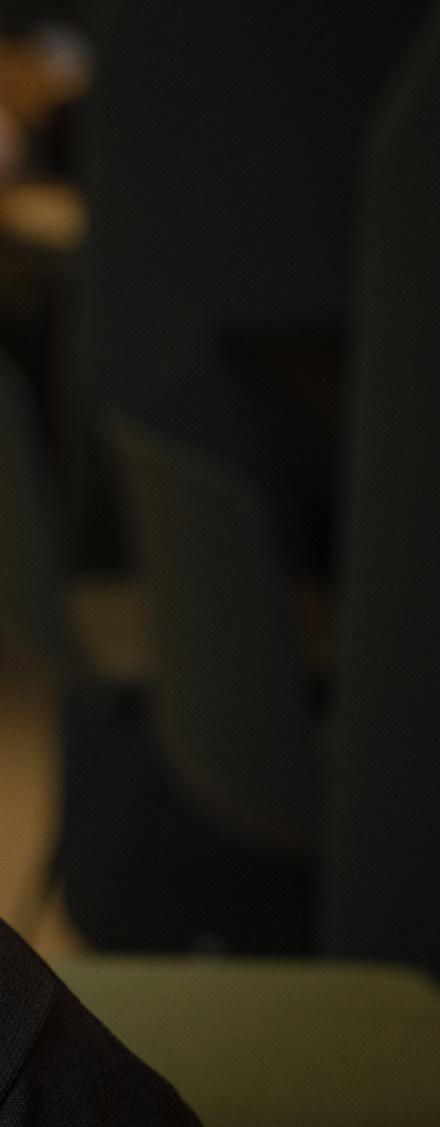
have the right to revitalise, use, develop and pass on to future generations their history, language, oral traditions, philosophies, writing systems, and literature.
In North America, as well as some other places, groups and communities are working to restore and give new life to endangered languages, partly using language and culture programmes. Native speakers of the language are recorded and sometimes videotaped. Through strengthening languages, societies and cultures are also strengthened, and vice versa.
– We linguists help document and study languages on a deeper level by looking for patterns of similarities and
differences in how languages take form, are learned and taught.
In this ocean of languages, how has she chosen which languages to focus on?
– Sometimes, it’s as though languages choose me, says Leora Bar-el.
She wrote her doctoral thesis in Vancouver on Squamish, an indigenous language spoken by a people of the same name. For 8,000–10,000 years they had settlements in the area that today is the city of Vancouver in British Columbia. Squamish belongs to the Salish language family, with languages spoken in northwestern North America, including Montana. Leora Bar-el has more recently been studying the Salish language Séliš-Ql̓ispé, spoken in Montana.
As a guest professor, Leora Bar-el is based at the Department of Philosophy, Linguistics, and Theory of Science, FloV.
– I’ve been really well received at FloV and have had the opportunity to teach, meet students, and participate in seminars.
Alongside Malin Petzell at the Department of Languages and Literatures, and Ponsiano Kanijo at Mkwawa University College in Tanzania, she studies previously undocumented Bantu languages in Tanzania.
Leora Bar-el also wishes to debunk myths about language and promote people’s appreciation of linguistic diversity by raising awareness of different languages and the importance of preserving dialects.
– People often say they don’t have time to learn a new language, but simply learning about languages helps to protect linguistic diversity, says Leora Bar-el.
Knowledge of how we learn languages is also the key to understanding our own nature, she further explains.
– Without linguistic diversity, we would not understand the human mind. When you learn another language, you can’t help but also learn about other cultures and societies as well. Doors open up to a global world and you realise that you’re part of something much bigger. At the same time, you learn more about yourself and your own language, things you likely wouldn’t have noticed otherwise. Linguistic diversity has several important advantages. Language skills improve connections in the brain, slows down the effects of dementia, according to various studies.
»There is so much more to learn from underdocumented and endangered languages.«
LEORA BAR-EL
Leora Bar-el became interested in languages at an early age. She grew up in a multilingual family outside of Toronto, Canada, and attended a bilingual school where they spoke English and Hebrew. Her father’s parents came from Russia and moved to Israel, from where her father moved to Canada. Her mother’s parents came from Poland. Although she was surrounded by different languages, it was only once she entered university that she discovered the field of linguistics.
– I took an introductory course and was immediately hooked, says Leora Barel. When you come to study linguistics, it becomes almost impossible not to spot the patterns in speech and writing. It’s beautiful. You don’t even need to know how to speak a language, as just learning a bit about it will help you see the patterns.
In the US, linguistics is considered a “discovery” subject, one people are unaware of unless they happen to come across it at university. Leora Bar-el and her colleagues are trying to ignite an interest from high school students, some of whom they hope will come to choose linguistics once they enter university.
– The world needs many more linguists! There is so much more to learn from underdocumented and endangered languages. Because of linguistic diversity, the world is more dynamic and vibrant.
Text and photo: Anna Rehnberg
Facts: Torgny Segerstedt’s guest professorship is financed by Torgny Segerstedt Memorial Foundation. Professor Leora Bar-el is Segerstedt-professor until the 31st of May, 2024.
Stephen Zunes, professor of politics at the University of San Francisco, is also Segerstedt-professor this spring.
GUJOURNAL MARCH 2024 21
There are around 7,000 languages in the world and Leora Bar-el would like to know them all.

Marina Panova is new manager at Tjärnö
Just over twenty years ago, Marina Panova came to Tjärnö Marine Laboratory for the first time. She was an exchange student and had no plans to stay for long. But life can take unexpected turns: Marina became a PhD student and started a career as a researcher at the Department of Marine Sciences. At the turn of the year, she succeeded Kerstin Johannesson as Tjärnö's station manager.
Why do you want to work as station manager at the Tjärnö Laboratory?
– Because Tjärnö is a fantastic workplace with wonderful people! The station means a lot to me. I have been at Tjärnö for
more than 20 years, and I am absolutely convinced that the station has a very high value for research, education, and collaboration at our university, and that it can contribute even more in the future.
What have you done previously?
– I studied biology at St Petersburg University before coming to Sweden and started my work on the genetics of marine organisms, which is my main interest. For the last five years my research has been on the development of eDNA as a tool for environmental monitoring in the sea. I have also been the director of studies for our department for five years, and for the past two years I have been deputy director of the Centre for Sea
and Society at the University of Gothenburg.
When did you first come to Tjärnö?
– I came to Tjärnö in 1999 as an exchange student to work with Kerstin Johannesson on the genetics of rough periwinkle snails. Then I got a PhD position with Kerstin in 2003. Tjärnö was one of the few places in the world to study the genetics of marine organisms at that time. However, I had no plans to stay...
Will you have time to do any research now?
– I hope so, that's the plan! It's important both for Tjärnö and for the Centre for Sea and Society that I have a close connection with research. I will continue to work with
eDNA studies in the sea, for example how biodiversity is affected by mussel and seaweed farming.
What do you like to do in your free time?
– I am like our cat: outside in summer and inside in winter. In summer I grow my own vegetables, work in the garden, walk in the forest and go to the sea. In winter I cuddle up inside with books, TV, puzzles, and various home projects. Our house will be 100 years old next year and there is always something to repair. And I always have my dog with me, both in the forest and on the sofa.
22 GUJOURNAL MARCH 2024
Interview and photo: Susanne Liljenström







 MALIN BROBERG
MALIN BROBERG























